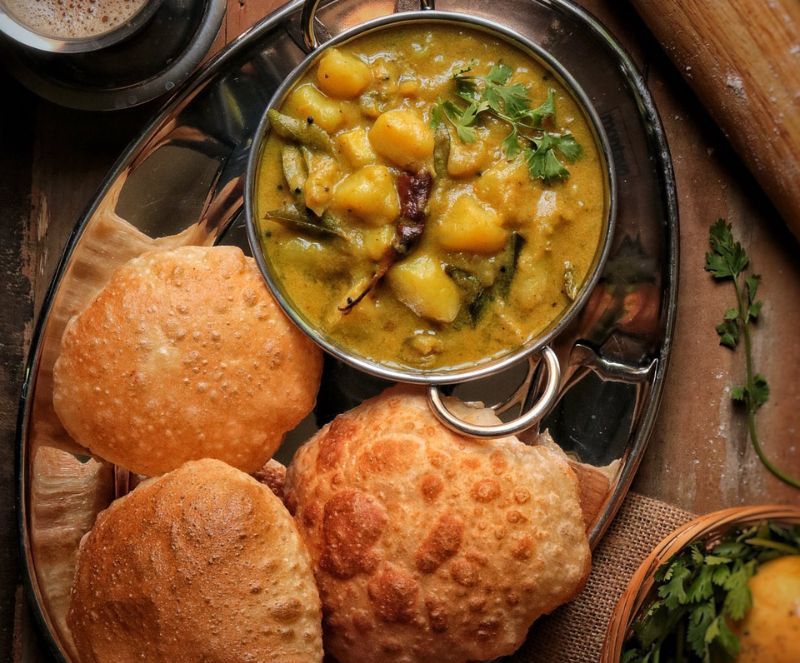India has an extraordinarily rich culinary heritage with recipes that go back hundreds of years. With its 28 states and eight union territories, each region brings something to the table. However, as diverse as Indian food may be, there are many dishes that are commonly made throughout the country, all crafted with a family’s unique spin to make something familiar taste truly original and inviting. We’re not going to attempt a deep dive into Indian food (because that would require an encyclopedia or two), but we will break down the essentials. Follow this guide when you’re eating Indian food anywhere—even in India—so you know exactly what to ask for to ensure your meal is vegan. For the sake of convenience, we’re classifying the food from India into four different regions they originate from: North, South, West, and East. Remember that within these regions there may be variations, but with this guide you will be able to maneuver your way through the labyrinth of popular Indian cuisine.
India: a vegetarian paradise
India is a great place for vegetarians, as it’s highly populated with individuals who abstain from meat. Some surveys go so far as to claim that 30 percent of the population follow a vegetarian diet.

While up to a third of the residents don’t eat meat, dairy is quite common in many traditional Indian diets. This abundant use of dairy is a fairly recent phenomenon—for centuries, it was unattainable for most people due to its high cost. Spices are also an essential part of the culinary culture—they’re essential to the distinctive flavor of Indian food. It’s not uncommon to enjoy a dish crafted with 15 or more spices at a time! While spices like turmeric, cumin, and chilies are used throughout India, the way they are used differ according to the region the dish originates from. Here is your primer broken down by these regions.
North India
The landscape of North India spans hilly holiday destinations that are part of the Indian Himalayas, the grassy fertile plains of rivers, and the Thar Desert.
The food that comes from this diverse area echoes these various climatic sentiments. North Indian savory food uses more warming spices like cumin and cinnamon and depends on fresh green chilies to add quite a bit of heat.
This kind of food also has a reputation for being very heavy on dairy (especially cottage cheese—called paneer and cream), eggs, and even meat. Despite this animal-based ingredient dependence, it’s not off the table for vegan eaters—you just have to know what to order.
Staple North Indian vegan dishes include flatbreads or rotis either roasted on the pan or fried into puffy pooris made from wheat flour served with a side of a legume-based gravy made with chickpeas, kidney beans, black gram, or pigeon peas and a dry vegetable dish like pan-fried spiced potatoes (aloo) or okra (bhindi).
Many times, the rotis are turned into parathas which are usually stuffed flatbreads, among them aloo…
Read more:Your Vegan Guide to Indian Food: From Flatbreads to Gravies









 Bitcoin
Bitcoin  Ethereum
Ethereum  Tether
Tether  Solana
Solana  XRP
XRP  Dogecoin
Dogecoin  USDC
USDC  Cardano
Cardano  Lido Staked Ether
Lido Staked Ether  Avalanche
Avalanche  TRON
TRON  Toncoin
Toncoin  Stellar
Stellar  Wrapped stETH
Wrapped stETH  Shiba Inu
Shiba Inu  Wrapped Bitcoin
Wrapped Bitcoin  Polkadot
Polkadot  Chainlink
Chainlink  WETH
WETH  Bitcoin Cash
Bitcoin Cash  Sui
Sui  NEAR Protocol
NEAR Protocol  Pepe
Pepe  LEO Token
LEO Token  Uniswap
Uniswap  Litecoin
Litecoin  Aptos
Aptos  Wrapped eETH
Wrapped eETH  Hedera
Hedera  Internet Computer
Internet Computer  USDS
USDS  Cronos
Cronos  Ethereum Classic
Ethereum Classic  Bittensor
Bittensor  POL (ex-MATIC)
POL (ex-MATIC)  Render
Render  Artificial Superintelligence Alliance
Artificial Superintelligence Alliance  Ethena USDe
Ethena USDe  Arbitrum
Arbitrum  Celestia
Celestia  Dai
Dai  Filecoin
Filecoin  Stacks
Stacks  WhiteBIT Coin
WhiteBIT Coin  Bonk
Bonk  Cosmos Hub
Cosmos Hub  OKB
OKB